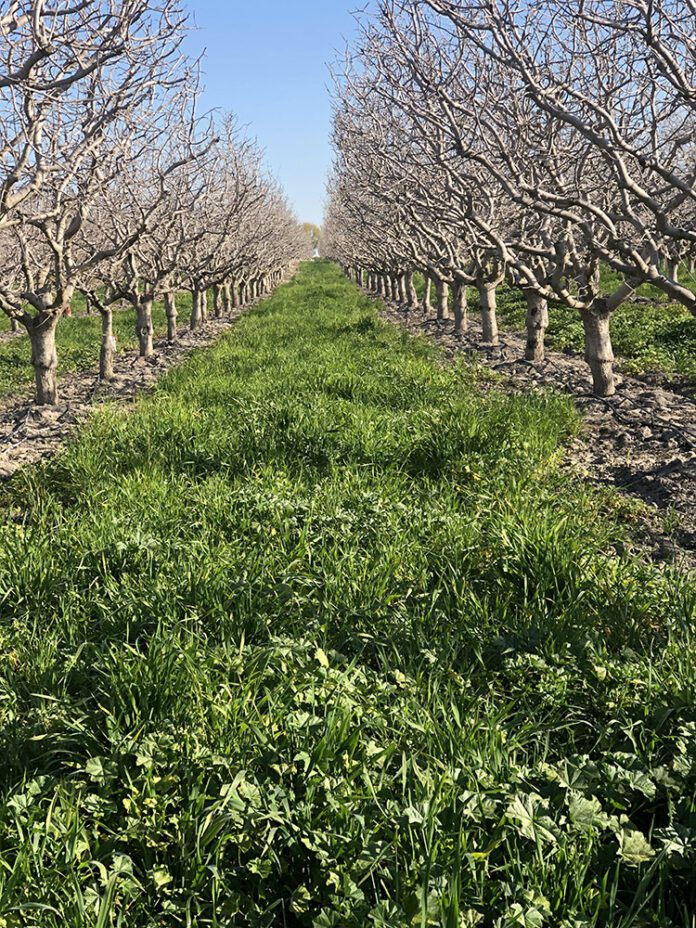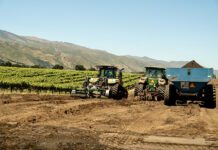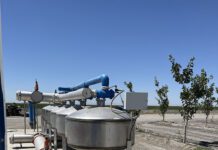
Listen to the audio version of this article. (Generated by A.I.)
What does “healthy soil” actually mean in a pistachio orchard, and how can growers measure it in a way that drives decisions, not just lab reports? In a recent two-part MyAgLife radio segment with UCCE Farm Advisor Mae Culumber, American Pistachio Growers’ Joe Coelho and pistachio grower and APG board member Justin Wylie, three perspectives aligned around a simple idea with big management implications: Soil health is the orchard’s built-in reservoir for water and nutrients, a buffer that helps trees ride out stress between irrigations and fertilizer applications.
Culumber’s definition starts with capacity and function rather than a single score. “A basic way of thinking about it is trying to cultivate a reservoir for nutrients and moisture that can help trees bridge those times of stress, whether that is between fertilization periods or between irrigation periods,” she said. “When you have accumulations of organic matter, that’s what creates the conditions where the soil acts a little bit more like a sponge to hold moisture and nutrients for a longer period of time.”
Coelho underscored that pistachio growers have always chased these traits, even before “soil health” became common vocabulary. “We have always been trying to farm for a healthy soil, a well-aggregated soil that drains well, that has the ability to flush salt, that holds water, that is a reservoir of nutrients,” he said. “There have been lots of approaches with things like calcium, with lime or with sulfur.”
He contrasted single-nutrient inputs with organic amendments that stack benefits.
“Say I am targeting potassium. Manure-based compost often has very high potassium per ton,” Coelho said. “If I just applied sulfate of potash, I am only getting the SOP, but with compost I can also apply 150 pounds of potassium in three tons of manure, getting a lot of other things out of it as well.”
Wylie framed the definition through a grower’s operational lens: Use tools that build organic matter and biology and watch how the system responds in real time.
“If you are measuring soil respiration and you are measuring soil organic matter, you can actually see how your inputs affect it,” he said. “Install real-time sensors on an orchard that is not under soil health practices and then the one you are experimenting on. To be able to see the difference is pretty phenomenal.”
“Soil health is the orchard’s built-in reservoir for water and nutrients, a buffer that helps trees ride out stress between irrigations and fertilizer applications.” – Mae Culumber, UCCE
The Indicators that Matter
While soil health can feel abstract, Culumber and Wylie pointed to a short list of practical, research-backed indicators that map directly to functions growers care about:
Organic matter
Culumber called organic matter the standard indicator for tracking whether practices are making a meaningful difference. “Measuring organic matter is the standard for evaluating if resilient practices are actually impacting the soil,” she said, adding a caution. “Those changes can be really slow over time, and there can be a lot of variability in your field.”
Use organic matter to track trends, not quick jumps.
Bulk density.
If organic matter tells you about the sponge, bulk density tells you about the pores that move air and water. “Bulk density is really important. It tells you how much pore space you have in the soil,” Culumber said. “We tend to see lower bulk density numbers in scenarios where you have compaction. These are good indicators to track the dynamics within the orchard over time, particularly when you are making a change.”
Microbial activity and respiration.
For a quick reality check on how alive a soil is, small-footprint respiration tests can help. “You can do very simple measurements that give you a baseline for respiration. If you have low respiration rates, that means you have low microbial activity,” Culumber said. More advanced microbial community analyses exist, but most day-to-day decisions can be steered with respiration plus organic matter.
Wylie emphasized pairing organic matter with real-time respiration to make management responsive. “Anytime you have real-time data, being able to see it online and watch that curve as you go into nut fill and say, ‘Oh man, it is tanking within 24 or 48 hours,’ and look at my water usage vs opening a box in the field, it is night and day,” he said.

When to Measure Across the Season
Sampling calendars should match goals and the metrics being tracked. Traditional salinity and suitability snapshots still have a place, but biological signals often need a different timing.
Coelho was candid about the industry’s starting point. “Many of the growers I work with have a fairly antiquated approach, a standard soil salinity and suitability test with base saturation,” he said. “That does not tell you the same thing as some of these more novel metrics.”
On timing, he said, “Generally we pull soils in fall after a season of irrigation and then in spring and after a rainy season, or at the completion of amendment applications.” If a grower is trying to understand microbial life or organic matter while making in-season applications, more frequent sampling throughout the season may be required given that carbon is transitory and biology fluctuates.
Wylie’s advice is to compare your orchard to itself and shorten the feedback loop. “Your soil is your soil. You cannot compare yourself to everyone else, but you want to be able to see where you are going and what effects your practices are having,” he said. “Short of sensors, measuring several times a year and looking at soil respiration and organic matter are super important.”
Putting It Together in the Orchard
The panel’s guidance points to a practical playbook pistachio growers can adapt by block:
• Clarify the function to improve. Is the challenge infiltration after winter storms, salt accumulation or midseason nutrient stress? Pick indicators that reflect the function. Emphasize bulk density and infiltration for compaction, and respiration and organic matter where biology seems sluggish.
• Stack tools to stack benefits. Keep proven structure builders like calcium, lime and sulfur where they fit, and pair them with compost or green waste that build carbon. “We have an abundance of plant waste and manure from dairies that can solve a number of problems,” Coelho said.
• Target potassium smarter. If potassium removal is the driver, consider manure-based compost to meet units while investing in the soil’s buffering capacity. As Coelho noted, compost can deliver potassium plus organic matter and co-benefits that a single salt cannot.
• Use cover crops intentionally. Diverse mixes during transition years can accelerate aggregation and feed microbial communities. Watch which species dominate and adjust disturbance or mix the following year.
• Measure on a cadence that answers your question. Keep the fall and post-rain snapshots for salts and suitability but add in-season respiration and organic matter checks when you are trialing biological or carbon strategies. “The frequency probably increases to more in-season sampling than out of season,” Coelho said.
• Use real-time where feasible. Pair a transitioning block with a conventional reference and monitor respiration through critical windows like nut fill. “Being able to see it online within 24 to 48 hours, it is night and day,” Wylie said.
In pistachios, soil health is not an abstract score; it is the soil’s ability to act as a reservoir, smoothing out stress between irrigations and fertilizer passes and lowering risk when labor, water or markets are tight. Organic matter, bulk density and microbial activity give growers a workable dashboard. Compost, cover crops and time-tested structure builders supply multiple benefits when used together and adjusted as soils improve. Most important, measurement should match intent. Pair the standard seasonal snapshots with in-season biological checks or real-time sensors when you want to see how practices perform under real orchard pressure. To paraphrase Culumber, building this reservoir lets soils mitigate stress and keeps pistachio trees productive.

Taylor Chalstrom
Taylor is the new Digital Content Editor at JCS Marketing Inc., coming on to the team in June 2020 as an editorial intern. He previously attended Cal Poly, San Luis Obispo, earning a degree in Agricultural Science and a minor in Agricultural Communication. Taylor wrote for AgCircle, Cal Poly’s award-winning agriculture magazine produced by the Brock Center for Agricultural Communication, for two and a half years before becoming Brock’s Associate Editor for writing in his final year at Cal Poly.















